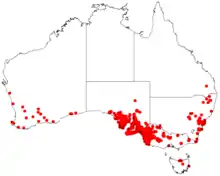Lepidosperma viscidum
Lepidosperma viscidum, the sticky saw sedge, is a grass like plant found in south eastern Australia. Usually seen in heath and woodland on sandy and rocky sites, it may grow to 60 centimetres high.[1] This is one of the many plants first published by Robert Brown with the type known as "(M.) v.v." appearing in his Prodromus Florae Novae Hollandiae et Insulae Van Diemen in 1810. The specific epithet viscidum is derived from the Latin with a meaning of "sticky", which refers to the sticky resin from the base and margins of the leaves and stem margins. On drying, the resin turns a red colour.[2]
| sticky saw sedge | |
|---|---|
.jpg.webp) | |
| Scientific classification | |
| Kingdom: | Plantae |
| Clade: | Tracheophytes |
| Clade: | Angiosperms |
| Clade: | Monocots |
| Clade: | Commelinids |
| Order: | Poales |
| Family: | Cyperaceae |
| Genus: | Lepidosperma |
| Species: | L. viscidum |
| Binomial name | |
| Lepidosperma viscidum | |
 | |
| Occurrence data from AVH | |
References
- "Lepidosperma viscidum, PlantNET - NSW Flora Online". Retrieved 13 April 2019.
- Les Robinson - Field Guide to the Native Plants of Sydney, ISBN 978-0-7318-1211-0 page 294
This article is issued from Wikipedia. The text is licensed under Creative Commons - Attribution - Sharealike. Additional terms may apply for the media files.